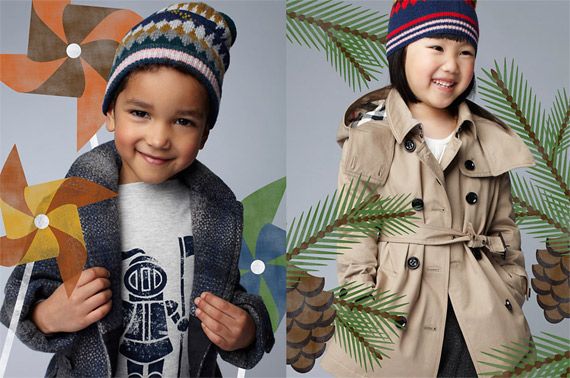
Photo Courtesy of Burberry
Luxury brands are pushing forward with products and services for children, hoping to catch the attention of status conscious parents.
Alongside numerous services for ?Very Important People?, Four Seasons Hotels and Resorts now offer services to ?Very Important Kids? staying in its hotels. They are just one of many luxury hotel chains to have developed bespoke programs for children in the last few years, as travellers bring wee ones to high-price hotels in never-before seen numbers (WSJ).
In what is billed as the ?ultimate luxury hotel experience for children,? underage guests at the Four Seasons Berlin can whizz around the lobby in a miniature Mercedes-Benz, take high tea using child-friendly china and petite gold furniture, and step up at the front desk using a mahogany set of ?children?s check-in? stairs (The Independent).
At Rosewood Hotels & Resorts, guests between nine and thirteen years of age can indulge in a range of spa services, with manicures and pedicures for children as young as five. The brand launched a children?s program in 2011, entitled Rose Buds, which draws on the Montessori approach to educating young children, available at its 17 hotels world-wide.
Paris?s Hôtel Plaza Athénée launched bespoke children?s rooms in August 2011, decked from ceiling to floor with Barbie™ or Hot Wheels™ accessories. The iconic luxury hotel offers its youngest guests milk and cookies on arrival, alongside child-size robes and slippers, a dedicated children?s menu and child-minding services for parents wishing to have a romantic night on the town.
The Mandarin Oriental Hotel Group has begun training employees on the stages of infant and child development, so that staff members will know at what age to offer a high chair and recommend the most suitable services to guests. At the Peninsula in Hong Kong, children are offered a ride in the house Rolls-Royce.
After years of focusing on business travellers, and affluent couples in metropolitan cities, luxury hotel brands are beginning to realise the value of indulging the children of the affluent. Particularly given the increasing wealth in Asia and the Middle East, in cultures that are intrinsically familial and often travel together.
Apparel companies are following a similar tack. At the Louis Vuitton Mall of the Emirates store, one will find a dedicated family room to entertain large groups of all ages, whilst one of two family members are tended to by sales assistants. Burberry has chosen to focus on Asia and the Middle East for the majority of its free-standing children?s stores. And it?s turning out to represent big business.
£66 million of Burberry?s 2011-2012 revenue came from the sale of children?s wear, marking underlying growth of 19% for the category, driven by the Asia Pacific region. The brand opened eight new children?s wear stores in the year alone.

Most recently, Giorgio Armani has confirmed the launch of Armani Junior in India, with the assistance of local designer Suneet Varma. Mr. Varma?s firm, Unique Eye Luxury Apparel, along with some partners has inked a three-store deal, after detailed research on the future potential of the different segments of the luxury market identified kids wear as a key opportunity (Hindu Business Line).
Dior launched children?s wear in 1967, followed some decades later by Ralph Lauren, and more recently by Gucci, Stella McCartney, Marni and Lanvin. Oscar de la Renta, Fendi, Marc Jacobs, Roberto Cavalli, Missoni, Milly and Phillip Lim are recent additions to the underage apparel game, most of which focus on the replication of key runway looks and iconic garments in miniature.
?I would believe that none of these guys are doing it to make money," explained Theory CEO Andrew Rosen to the New York Times. "It?s all about being more relevant. This is talking to the 1 percent, or the less than 1 percent, of the population. You want to keep the customers engaged in your brand.?
But concerns have been raised as to the somewhat astounding prices and the comparative quality to that of primary adult collections. ?Children have big tummies and stand in funny ways,? suggested British children?s wear designer Rachel Riley, rendering miniature versions of catwalk styles not only impractical but uncomfortable and unflattering when worn.
?On their main line, they would have never done something like this,? said Mr. Rosen, when presented with a $375 silk girl?s Gucci dress, where the print had not been matched on a seam. Aggressively pursuing new revenue streams has become part and parcel of the intense industrialisation of luxury, but such a serge of interest in children?s wear begs the question of ?How far is too far when it comes to category expansion??
Speaking at the 2011 Financial Times Business of Luxury Summit, Balenciaga CEO Isabelle Guichot ruled out a move into children?s wear as long as she was in the top spot. Mos. Guichot confirmed that the brand had looked into the market for kids, but was eventually missing a credible link to Balenciaga?s heritage and its positioning as a serious fashion brand.
Yet the business case remains compelling, particularly at a time when designers and CEOs report to the chairs of luxury conglomerates and public shareholders, and when the children?s apparel market is estimated at $34 billion in the U.S. alone.
Though luxury sales only currently account for 3% of that figure, it?s said to be growing at a far more rapid rate than the rest of the category, according to research firm NPD Group Inc. And for the moment, interest in the category shows no sign of slowing down.









